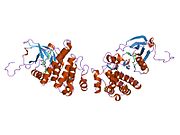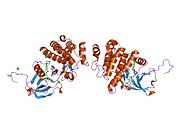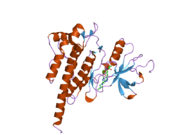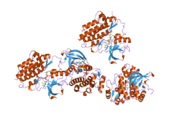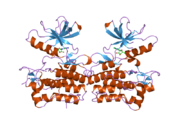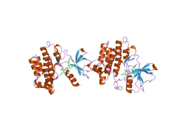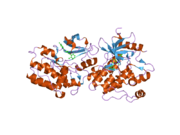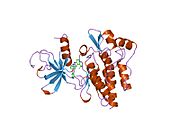Biology:ABL (gene)
 Generic protein structure example |
Tyrosine-protein kinase ABL1 also known as ABL1 is a protein that, in humans, is encoded by the ABL1 gene (previous symbol ABL) located on chromosome 9.[1] c-Abl is sometimes used to refer to the version of the gene found within the mammalian genome, while v-Abl refers to the viral gene, which was initially isolated from the Abelson murine leukemia virus.[2]
Function
The ABL1 proto-oncogene encodes a cytoplasmic and nuclear protein tyrosine kinase that has been implicated in processes of cell differentiation, cell division, cell adhesion, and stress response such as DNA repair.[3][4][5][6] Activity of ABL1 protein is negatively regulated by its SH3 domain, and deletion of the SH3 domain turns ABL1 into an oncogene. The t(9;22) translocation results in the head-to-tail fusion of the BCR and ABL1 genes, leading to a fusion gene present in many cases of chronic myelogenous leukemia. The DNA-binding activity of the ubiquitously expressed ABL1 tyrosine kinase is regulated by CDC2-mediated phosphorylation, suggesting a cell cycle function for ABL1. The ABL1 gene is expressed as either a 6- or a 7-kb mRNA transcript, with alternatively spliced first exons spliced to the common exons 2–11.[7]
Clinical significance
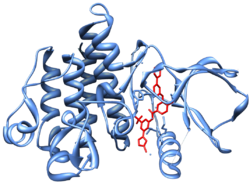
Mutations in the ABL1 gene are associated with chronic myelogenous leukemia (CML). In CML, the gene is activated by being translocated within the BCR (breakpoint cluster region) gene on chromosome 22. This new fusion gene, BCR-ABL, encodes an unregulated, cytoplasm-targeted tyrosine kinase that allows the cells to proliferate without being regulated by cytokines. This, in turn, allows the cell to become cancerous.
This gene is a partner in a fusion gene with the BCR gene in the Philadelphia chromosome, a characteristic abnormality in chronic myelogenous leukemia (CML) and rarely in some other leukemia forms. The BCR-ABL transcript encodes a tyrosine kinase, which activates mediators of the cell cycle regulation system, leading to a clonal myeloproliferative disorder. The BCR-ABL protein can be inhibited by various small molecules. One such inhibitor is imatinib mesylate, which occupies the tyrosine kinase domain and inhibits BCR-ABL's influence on the cell cycle. Second generation BCR-ABL tyrosine-kinase inhibitors are also under development to inhibit BCR-ABL mutants resistant to imatinib.[8]
Interactions
ABL gene has been shown to interact with:
- ABI1,[9][10][11]
- ABI2,[12][13]
- ABL2,[12]
- ATM,[14][15][16]
- BCAR1,[17][18]
- BCR,[19][20][21]
- BRCA1,[22]
- CAT,[23]
- CBL,[24][25]
- CRKL,[26][27][28]
- DOK1,[29][30]
- EPHB2,[31]
- GPX1,[32]
- GRB10,[33][34]
- MTOR,[35]
- GRB2,[26][36]
- MDM2,[37]
- NCK1,[24][26]
- NEDD9,[38][39]
- NTRK1,[40][41]
- P73,[42][43]
- PAG1,[44]
- PAK2,[45]
- PSTPIP1,[46]
- RAD9A,[47]
- RAD51,[14]
- RB1,[48][49]
- RFX1,[50]
- RYBP,[51]
- SHC1,[19][52]
- SORBS2,[25][53]
- SPTA1,[54]
- SPTAN1,[54]
- TERF1,[16]
- VAV1,[55] and
- YTHDC1.[56]
Regulation
There is some evidence that the expression of Abl is regulated by the microRNA miR-203.[57]
See also
- BCR gene
References
- ↑ "Selective inhibition of leukemia cell proliferation by BCR-ABL antisense oligodeoxynucleotides". Science 253 (5019): 562–5. August 1991. doi:10.1126/science.1857987. PMID 1857987. Bibcode: 1991Sci...253..562S.
- ↑ "Lymphosarcoma: virus-induced thymic-independent disease in mice". Cancer Research 30 (8): 2213–22. August 1970. PMID 4318922.
- ↑ "Mutational analyses of the human Rad51-Tyr315 residue, a site for phosphorylation in leukaemia cells". Genes to Cells 9 (9): 781–90. September 2004. doi:10.1111/j.1365-2443.2004.00772.x. PMID 15330855.
- ↑ "BCR-ABL stimulates mutagenic homologous DNA double-strand break repair via the DNA-end-processing factor CtIP". Carcinogenesis 32 (1): 27–34. January 2011. doi:10.1093/carcin/bgq216. PMID 20974687.
- ↑ "Targeting DNA Homologous Repair Proficiency With Concomitant Topoisomerase II and c-Abl Inhibition". Frontiers in Oncology 11: 3666. 2021. doi:10.3389/fonc.2021.733700. PMID 34616682.
- ↑ "UniProtKB - P00519 (ABL1_HUMAN)". https://www.uniprot.org/uniprot/P00519.
- ↑ "Entrez Gene: ABL1 v-abl Abelson murine leukemia viral oncogene homolog 1". https://www.ncbi.nlm.nih.gov/sites/entrez?Db=gene&Cmd=ShowDetailView&TermToSearch=25.
- ↑ "Overriding imatinib resistance with a novel ABL kinase inhibitor". Science 305 (5682): 399–401. July 2004. doi:10.1126/science.1099480. PMID 15256671. Bibcode: 2004Sci...305..399S.
- ↑ "Abl interactor 1 promotes tyrosine 296 phosphorylation of mammalian enabled (Mena) by c-Abl kinase". J. Biol. Chem. 278 (24): 21685–92. June 2003. doi:10.1074/jbc.M301447200. PMID 12672821.
- ↑ "Isolation and characterization of e3B1, an eps8 binding protein that regulates cell growth". Oncogene 14 (2): 233–41. January 1997. doi:10.1038/sj.onc.1200822. PMID 9010225.
- ↑ "Isolation of hNap1BP which interacts with human Nap1 (NCKAP1) whose expression is down-regulated in Alzheimer's disease". Gene 271 (2): 159–69. June 2001. doi:10.1016/S0378-1119(01)00521-2. PMID 11418237.
- ↑ 12.0 12.1 "Functional interaction between the c-Abl and Arg protein-tyrosine kinases in the oxidative stress response". J. Biol. Chem. 278 (15): 12961–7. April 2003. doi:10.1074/jbc.M300058200. PMID 12569093.
- ↑ "Abi-2, a novel SH3-containing protein interacts with the c-Abl tyrosine kinase and modulates c-Abl transforming activity". Genes Dev. 9 (21): 2569–82. November 1995. doi:10.1101/gad.9.21.2569. PMID 7590236.
- ↑ 14.0 14.1 "Radiation-induced assembly of Rad51 and Rad52 recombination complex requires ATM and c-Abl". J. Biol. Chem. 274 (18): 12748–52. April 1999. doi:10.1074/jbc.274.18.12748. PMID 10212258.
- ↑ "Interaction between ATM protein and c-Abl in response to DNA damage". Nature 387 (6632): 520–3. May 1997. doi:10.1038/387520a0. PMID 9168117. Bibcode: 1997Natur.387R.520S.
- ↑ 16.0 16.1 "Telomeric protein Pin2/TRF1 as an important ATM target in response to double strand DNA breaks". J. Biol. Chem. 276 (31): 29282–91. August 2001. doi:10.1074/jbc.M011534200. PMID 11375976.
- ↑ "p130CAS forms a signaling complex with the adapter protein CRKL in hematopoietic cells transformed by the BCR/ABL oncogene". J. Biol. Chem. 271 (41): 25198–203. October 1996. doi:10.1074/jbc.271.41.25198. PMID 8810278.
- ↑ "Evidence that SH2 domains promote processive phosphorylation by protein-tyrosine kinases". Curr. Biol. 5 (3): 296–305. March 1995. doi:10.1016/S0960-9822(95)00060-1. PMID 7780740.
- ↑ 19.0 19.1 "Bcr-Abl oncoproteins bind directly to activators of the Ras signalling pathway". EMBO J. 13 (4): 764–73. February 1994. doi:10.1002/j.1460-2075.1994.tb06319.x. PMID 8112292.
- ↑ "Bcr and Abl interaction: oncogenic activation of c-Abl by sequestering Bcr". Cancer Res. 63 (2): 298–303. January 2003. PMID 12543778.
- ↑ "BCR sequences essential for transformation by the BCR-ABL oncogene bind to the ABL SH2 regulatory domain in a non-phosphotyrosine-dependent manner". Cell 66 (1): 161–71. July 1991. doi:10.1016/0092-8674(91)90148-R. PMID 1712671.
- ↑ "Constitutive association of BRCA1 and c-Abl and its ATM-dependent disruption after irradiation". Mol. Cell. Biol. 22 (12): 4020–32. June 2002. doi:10.1128/MCB.22.12.4020-4032.2002. PMID 12024016.
- ↑ "Catalase activity is regulated by c-Abl and Arg in the oxidative stress response". J. Biol. Chem. 278 (32): 29667–75. August 2003. doi:10.1074/jbc.M301292200. PMID 12777400.
- ↑ 24.0 24.1 "Regulation of Cbl phosphorylation by the Abl tyrosine kinase and the Nck SH2/SH3 adaptor". Oncogene 20 (30): 4058–69. July 2001. doi:10.1038/sj.onc.1204528. PMID 11494134.
- ↑ 25.0 25.1 "Cbl-ArgBP2 complex mediates ubiquitination and degradation of c-Abl". Biochem. J. 370 (Pt 1): 29–34. February 2003. doi:10.1042/BJ20021539. PMID 12475393.
- ↑ 26.0 26.1 26.2 "Abl protein-tyrosine kinase selects the Crk adapter as a substrate using SH3-binding sites". Genes Dev. 8 (7): 783–95. April 1994. doi:10.1101/gad.8.7.783. PMID 7926767.
- ↑ "Direct binding of CRKL to BCR-ABL is not required for BCR-ABL transformation". Blood 89 (1): 297–306. January 1997. doi:10.1182/blood.V89.1.297. PMID 8978305.
- ↑ "Differential interaction of Crkl with Cbl or C3G, Hef-1, and gamma subunit immunoreceptor tyrosine-based activation motif in signaling of myeloid high affinity Fc receptor for IgG (Fc gamma RI)". J. Immunol. 161 (10): 5555–63. November 1998. doi:10.4049/jimmunol.161.10.5555. PMID 9820532.
- ↑ "Stem cell factor induces phosphatidylinositol 3'-kinase-dependent Lyn/Tec/Dok-1 complex formation in hematopoietic cells". Blood 96 (10): 3406–13. November 2000. doi:10.1182/blood.V96.10.3406. PMID 11071635. https://pure.eur.nl/en/publications/395fb5fc-60e3-45d7-a9b1-fc7b9cc6b4bc.
- ↑ "Identification of the Abl- and rasGAP-associated 62 kDa protein as a docking protein, Dok". Cell 88 (2): 205–11. January 1997. doi:10.1016/S0092-8674(00)81841-3. PMID 9008161.
- ↑ "Multiple signaling interactions of Abl and Arg kinases with the EphB2 receptor". Oncogene 20 (30): 3995–4006. July 2001. doi:10.1038/sj.onc.1204524. PMID 11494128.
- ↑ "Glutathione peroxidase 1 is regulated by the c-Abl and Arg tyrosine kinases". J. Biol. Chem. 278 (41): 39609–14. October 2003. doi:10.1074/jbc.M305770200. PMID 12893824.
- ↑ "The SH2-containing adapter protein GRB10 interacts with BCR-ABL". Oncogene 17 (8): 941–8. August 1998. doi:10.1038/sj.onc.1202024. PMID 9747873.
- ↑ "Human GRB-IRbeta/GRB10. Splice variants of an insulin and growth factor receptor-binding protein with PH and SH2 domains". J. Biol. Chem. 272 (5): 2659–67. January 1997. doi:10.1074/jbc.272.5.2659. PMID 9006901.
- ↑ "Regulation of the rapamycin and FKBP-target 1/mammalian target of rapamycin and cap-dependent initiation of translation by the c-Abl protein-tyrosine kinase". J. Biol. Chem. 275 (15): 10779–87. April 2000. doi:10.1074/jbc.275.15.10779. PMID 10753870.
- ↑ "The Src family kinase Hck interacts with Bcr-Abl by a kinase-independent mechanism and phosphorylates the Grb2-binding site of Bcr". J. Biol. Chem. 272 (52): 33260–70. December 1997. doi:10.1074/jbc.272.52.33260. PMID 9407116.
- ↑ "Tyrosine phosphorylation of Mdm2 by c-Abl: implications for p53 regulation". EMBO J. 21 (14): 3715–27. July 2002. doi:10.1093/emboj/cdf384. PMID 12110584.
- ↑ "Structure and function of Cas-L, a 105-kD Crk-associated substrate-related protein that is involved in beta 1 integrin-mediated signaling in lymphocytes". J. Exp. Med. 184 (4): 1365–75. October 1996. doi:10.1084/jem.184.4.1365. PMID 8879209.
- ↑ "Human enhancer of filamentation 1, a novel p130cas-like docking protein, associates with focal adhesion kinase and induces pseudohyphal growth in Saccharomyces cerevisiae". Mol. Cell. Biol. 16 (7): 3327–37. July 1996. doi:10.1128/mcb.16.7.3327. PMID 8668148.
- ↑ "Direct interaction of nerve growth factor receptor, TrkA, with non-receptor tyrosine kinase, c-Abl, through the activation loop". FEBS Lett. 469 (1): 72–6. March 2000. doi:10.1016/S0014-5793(00)01242-4. PMID 10708759.
- ↑ "Association of the Abl tyrosine kinase with the Trk nerve growth factor receptor". J. Neurosci. Res. 59 (3): 356–64. February 2000. doi:10.1002/(SICI)1097-4547(20000201)59:3<356::AID-JNR9>3.0.CO;2-G. PMID 10679771.
- ↑ "p73 is regulated by tyrosine kinase c-Abl in the apoptotic response to DNA damage". Nature 399 (6738): 814–7. June 1999. doi:10.1038/21704. PMID 10391251. Bibcode: 1999Natur.399..814Y.
- ↑ "Interaction of c-Abl and p73alpha and their collaboration to induce apoptosis". Nature 399 (6738): 809–13. June 1999. doi:10.1038/21697. PMID 10391250. Bibcode: 1999Natur.399..809A.
- ↑ "The PAG gene product, a stress-induced protein with antioxidant properties, is an Abl SH3-binding protein and a physiological inhibitor of c-Abl tyrosine kinase activity". Genes Dev. 11 (19): 2456–67. October 1997. doi:10.1101/gad.11.19.2456. PMID 9334312.
- ↑ "Functional interaction between c-Abl and the p21-activated protein kinase gamma-PAK". Proc. Natl. Acad. Sci. U.S.A. 97 (26): 14346–51. December 2000. doi:10.1073/pnas.97.26.14346. PMID 11121037. Bibcode: 2000PNAS...9714346R.
- ↑ "Cytoskeletal protein PSTPIP1 directs the PEST-type protein tyrosine phosphatase to the c-Abl kinase to mediate Abl dephosphorylation". Mol. Cell 6 (6): 1413–23. December 2000. doi:10.1016/S1097-2765(00)00138-6. PMID 11163214.
- ↑ "c-Abl tyrosine kinase regulates the human Rad9 checkpoint protein in response to DNA damage". Mol. Cell. Biol. 22 (10): 3292–300. May 2002. doi:10.1128/MCB.22.10.3292-3300.2002. PMID 11971963.
- ↑ "Interaction of BCR-ABL with the retinoblastoma protein in Philadelphia chromosome-positive cell lines". Int. J. Hematol. 65 (2): 115–21. February 1997. doi:10.1016/S0925-5710(96)00539-7. PMID 9071815.
- ↑ "A C-terminal protein-binding domain in the retinoblastoma protein regulates nuclear c-Abl tyrosine kinase in the cell cycle". Cell 75 (4): 779–90. November 1993. doi:10.1016/0092-8674(93)90497-E. PMID 8242749.
- ↑ "The kinase activity of c-Abl but not v-Abl is potentiated by direct interaction with RFXI, a protein that binds the enhancers of several viruses and cell-cycle regulated genes". Oncogene 16 (14): 1779–88. April 1998. doi:10.1038/sj.onc.1201708. PMID 9583676.
- ↑ "c-ABL tyrosine kinase activity is regulated by association with a novel SH3-domain-binding protein". Mol. Cell. Biol. 16 (12): 7054–62. December 1996. doi:10.1128/mcb.16.12.7054. PMID 8943360.
- ↑ "A novel SH2-containing phosphatidylinositol 3,4,5-trisphosphate 5-phosphatase (SHIP2) is constitutively tyrosine phosphorylated and associated with src homologous and collagen gene (SHC) in chronic myelogenous leukemia progenitor cells". Blood 93 (8): 2707–20. April 1999. doi:10.1182/blood.V93.8.2707. PMID 10194451.
- ↑ "ArgBP2, a multiple Src homology 3 domain-containing, Arg/Abl-interacting protein, is phosphorylated in v-Abl-transformed cells and localized in stress fibers and cardiocyte Z-disks". J. Biol. Chem. 272 (28): 17542–50. July 1997. doi:10.1074/jbc.272.28.17542. PMID 9211900.
- ↑ 54.0 54.1 "Identification of a candidate human spectrin Src homology 3 domain-binding protein suggests a general mechanism of association of tyrosine kinases with the spectrin-based membrane skeleton". J. Biol. Chem. 273 (22): 13681–92. May 1998. doi:10.1074/jbc.273.22.13681. PMID 9593709.
- ↑ "Association of Bcr-Abl with the proto-oncogene Vav is implicated in activation of the Rac-1 pathway". J. Biol. Chem. 277 (14): 12437–45. April 2002. doi:10.1074/jbc.M112397200. PMID 11790798.
- ↑ "The intranuclear localization and function of YT521-B is regulated by tyrosine phosphorylation". Hum. Mol. Genet. 13 (15): 1535–49. August 2004. doi:10.1093/hmg/ddh167. PMID 15175272.
- ↑ "Genetic and epigenetic silencing of microRNA-203 enhances ABL1 and BCR-ABL1 oncogene expression". Cancer Cell 13 (6): 496–506. June 2008. doi:10.1016/j.ccr.2008.04.018. PMID 18538733.
Further reading
- "Transforming pathways activated by the v-Abl tyrosine kinase". Oncogene 21 (56): 8568–76. December 2002. doi:10.1038/sj.onc.1206084. PMID 12476303.
- "c-Abl: activation and nuclear targets". Cell Death Differ. 7 (1): 10–6. 2000. doi:10.1038/sj.cdd.4400626. PMID 10713716.
- "Bcr-Abl is a "molecular switch" for the decision for growth and differentiation in hematopoietic stem cells". Int. J. Hematol. 76 (1): 35–43. 2002. doi:10.1007/BF02982716. PMID 12138893.
- "The Abl family kinases: mechanisms of regulation and signaling". Advances in Cancer Research Volume 85. 85. 2002. 51–100. doi:10.1016/S0065-230X(02)85003-5. ISBN 978-0120066858.
- "Chronic myelocytic leukemia with eosinophilia, t(9;12)(q34;p13), and ETV6-ABL gene rearrangement: case report and review of the literature". Cancer Genet. Cytogenet. 138 (2): 139–42. 2002. doi:10.1016/S0165-4608(02)00609-X. PMID 12505259.
- "Abl: the prototype of oncogenic fusion proteins". Cell. Mol. Life Sci. 61 (23): 2897–911. 2004. doi:10.1007/s00018-004-4271-0. PMID 15583852.
- "Role of c-Abl in the DNA damage stress response". Cell Res. 15 (1): 33–5. 2005. doi:10.1038/sj.cr.7290261. PMID 15686624.
- "Regulation for Nuclear Targeting of the Abl Tyrosine Kinase in Response to DNA Damage". Advances in Molecular Oncology. Advances in Experimental Medicine and Biology. 604. Springer. 2007. pp. 155–65. doi:10.1007/978-0-387-69116-9_15. ISBN 978-0-387-69114-5. https://archive.org/details/advancesinmolecu00inte/page/155.
External links
- Genes,+abl at the US National Library of Medicine Medical Subject Headings (MeSH)
- Online Mendelian Inheritance in Man (OMIM) 189980 (ABL)
- Abelson+Leukemia+Virus at the US National Library of Medicine Medical Subject Headings (MeSH)
- Drosophila Abl tyrosine kinase - The Interactive Fly
- ABL1 Info with links in the Cell Migration Gateway
- ABL1 on the Atlas of Genetics and Oncology
- Human ABL1 genome location and ABL1 gene details page in the UCSC Genome Browser.
- Overview of all the structural information available in the PDB for UniProt: P00519 (Human Tyrosine-protein kinase ABL1) at the PDBe-KB.
- Overview of all the structural information available in the PDB for UniProt: P00520 (Mouse Tyrosine-protein kinase ABL1) at the PDBe-KB.
 |





